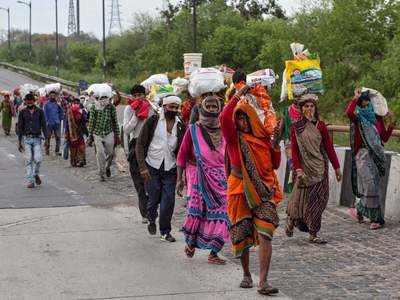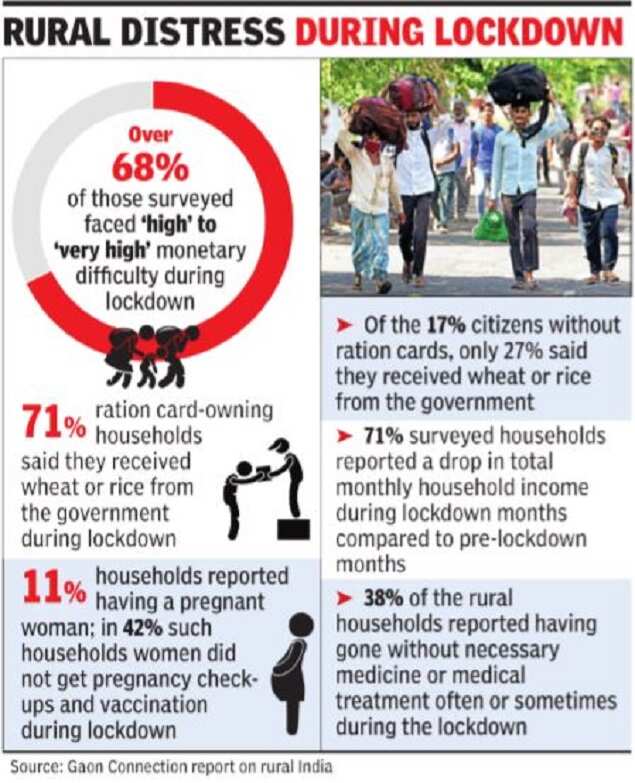
NEW DELHI: A comprehensive survey, covering 25,371 respondents in rural India, including households with 963 migrants who had returned during the lockdown, found that 22.5% or about one in four migrants interviewed said they undertook the journey on foot, while another 6.9% percent partly walked and used vehicular transport. About 2.6% said they cycled back to their villages.

While the survey does not share details of the distances travelled — relevant in terms of how far they were from native villages — their experience captures how economic distress, fear of Covid -19 and hunger led to people leaving cities in whatever mode of transport that was available. When asked if the local administration facilitated their return home, by giving money, train ticket, bus service or some other vehicle, some 409 responded in the affirmative and 554 said no. These were migrants who returned.
Of these migrants, 17.8% had returned to their villages by bus, 11.6% by train, 10.2% by car or jeep, 7.8% by truck and 1.5% by tractor. Once home, faced with hardships, many said they will return to cities after lockdown or when the epidemic subsided. One third (33%) said they would go back to cities and 16% weren’t sure.

While the survey does not share details of the distances travelled — relevant in terms of how far they were from native villages — their experience captures how economic distress, fear of Covid -19 and hunger led to people leaving cities in whatever mode of transport that was available. When asked if the local administration facilitated their return home, by giving money, train ticket, bus service or some other vehicle, some 409 responded in the affirmative and 554 said no. These were migrants who returned.
Of these migrants, 17.8% had returned to their villages by bus, 11.6% by train, 10.2% by car or jeep, 7.8% by truck and 1.5% by tractor. Once home, faced with hardships, many said they will return to cities after lockdown or when the epidemic subsided. One third (33%) said they would go back to cities and 16% weren’t sure.
Download
The Times of India News App for Latest India News

Coronavirus outbreak
Trending Topics
LATEST VIDEOS
India
 Treat quarantine period of doctors, health workers as 'on duty': Health ministry
Treat quarantine period of doctors, health workers as 'on duty': Health ministry  Rajasthan political crisis: Sachin Pilot committed to working for Cong, says party after his meeting with Rahul, Priyanka
Rajasthan political crisis: Sachin Pilot committed to working for Cong, says party after his meeting with Rahul, Priyanka  If we manufacture things within India, we’ll be able to save large section of capital of country: Rajnath Singh
If we manufacture things within India, we’ll be able to save large section of capital of country: Rajnath Singh  Houses, roads damaged due to cloudburst in Uttarakhand’s Rudraprayag
Houses, roads damaged due to cloudburst in Uttarakhand’s Rudraprayag  World Elephant Day Environment Ministry committed for betterment of jumbos, says Javadekar
World Elephant Day Environment Ministry committed for betterment of jumbos, says Javadekar  Rajnath Singh inaugurates ‘Atma-Nirbharta Week’
Rajnath Singh inaugurates ‘Atma-Nirbharta Week’
More from TOI
Navbharat Times
Featured Today in Travel
Quick Links
Coronavirus in MumbaiCoronavirus in KolkataCoronavirus in HyderabadCoronavirus in DelhiCoronavirus in BangaloreCoronavirus symptomsCoronavirus in IndiaWhat is CoronavirusCoronavirus NewsSolar EclipseNPRWhat is NRCCAB BillCAB and NRCRTI BillPodcast newsLok SabhaShiv SenaYSRCPCongressBJP newsUIDAIIndian ArmyISRO newsSupreme Court
Get the app



